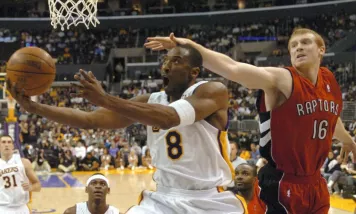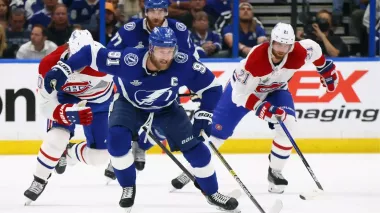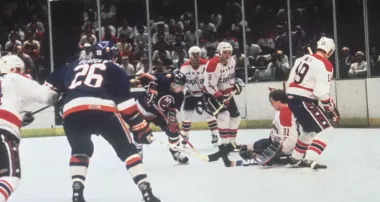
The NBA has experienced tremendous growth, evolution, and memorable moments since entering the 21st century. From record...

National Hockey League (NHL) is North America's professional ice hockey organization. It comprises 32 teams, among which 7 are from Canada and 25 are from the US.
In ice hockey, "strategies" refers to the planned, systematic steps teams take to achieve specific objectives during gameplay. By implementing well-defined strategies, teams aim to gain a competitive advantage, create scoring opportunities, limit opposition chances, and effectively control the game's flow. As seen on NHL Reddit streams, these strategies cover a range of areas of the game, including offensive methods, defensive formations, special teams, line changes, and overall team structure.
This article will discuss NHL hockey's Power Plays and Penalty Kills strategies.
When a team has one or two-man advantages on the ice due to an opposing player having a penalty, when one team violates the rules, the other team has power play for the next two minutes.

source - https://www.nhl.com/video/nhl-tonight-1-3-1-power-play/t-277774708/c-65444903
Listed below are some common types of power play strategies in NHL hockey games:
This strategy involves positioning players in the shape of an umbrella. One player sits at the center of the blue line, two positions themselves near the faceoff circles, and two act as a net-front presence. The objective is to create passing lanes and open up shooting opportunities from the point or through traffic in front of the net.
When it comes to strategies in NHL hockey, teams employ a variety of tactics to gain a competitive edge during games. In this strategy, the offensive team loads one side of the ice heavily. Three players set up on one half of the offensive zone, with one at the point and two down low near the goal line. This strategy aims to create numerical advantages and overload the defense to generate scoring chances. Here the players constantly move the puck into a corner. This, in turn, causes defensive breakdowns, thus creating beneficial scenarios.
The diamond strategy involves placing players in a diamond-shaped formation. One player acts as the quarterback at the top of the diamond, two players are positioned at the sides of the faceoff circles, and one player sets up in front of the net. This setup facilitates quick puck movement and creates shooting opportunities from different angles.
This strategy emphasizes spreading the defense by positioning players across the offensive zone. Players occupy various locations, including the point, half-boards, and behind the net. The objective is to create confusion among defenders and open up passing lanes or shooting opportunities.
In the swap strategy, players frequently switch positions during the power play. This movement disrupts the defense's coverage and creates mismatches or confusion. Players can rotate from the point to the half-boards or from the net-front position to the side of the net to generate scoring opportunities.
The cycling strategy involves maintaining puck possession in the offensive zone by utilizing quick passes and player movement. Players rotate positions, cycling the puck along the boards and behind the net, which can tire out defenders and create scoring chances through the net-front presence or open lanes.
Among the many strategies in NHL hockey, this strategy focuses on generating shots from the point and creating rebound opportunities. Players attempt to get the puck on the net quickly and position themselves for rebounds, aiming to capitalize on loose pucks or create chaos in front of the net.
When one or more of their players are serving penalties, the shorthanded team in ice hockey will employ the defensive tactic known as penalty killing. The goal of penalty-killing is stopping a power-play goal by the other team, which has a numerical advantage. With TotalSportek, NHL enthusiasts can enjoy the best NHL streams while immersing themselves in the exciting world of strategic gameplay in NHL hockey.

source - https://www.nhl.com/video/nhl-now-blues-penalty-kill/c-68420203
There are several penalty-killing strategies in NHL hockey. Given below are a few examples:
Teams in the defensive zone must deploy the best strategies in NHL hockey, as the power-playing team will do anything to take advantage of the defense’s weaknesses. Box, diamond, and triangle are the three common penalty-killing strategies.
Box formation is a popular strategy where four players create a box-like structure in the defensive zone. The player at the front of the box challenges the puck carrier while the other three players position themselves to block passing lanes and prevent shots on goal. This formation limits the opposing team's space and time, forcing them to take low-percentage shots.
Similar to box formation, the diamond formation also involves four players. However, in this strategy, one player positions themselves closer to the net, forming a diamond shape. The player at the front pressures the puck carrier while the other three players focus on blocking shots and disrupting passing lanes. This formation is effective at denying scoring opportunities from the slot area.
This setup is used when a 5-on-3 situation arises during a penalty kill in the defensive zone. In this situation, one forward will play in the slot area while the other two defenders remain on either side of the goalie, lower in the zone. The primary objectives of the triangle are to stop passes going to the front of the net and to stop shots coming from a point.
Dumping is a fundamental penalty-killing tactic. An icing penalty is when a team is at full strength; it will just hit the puck far outside the defensive zone and let it cross the goal line. However, it is not an icing penalty if the team is short-handed.

Check out in more detail - https://www.rookieroad.com/ice-hockey/basics/penalty-killing/
The wedge formation is an aggressive strategy where three players form a triangle in the defensive zone. The player at the front aggressively pressures the puck carrier while the other two players cover the passing lanes and attempt to intercept or disrupt plays. This formation aims to create turnovers and counter-attack opportunities.
Some penalty-killing units employ a high-pressure approach, aggressively challenging the opponent's power play unit. Players will aggressively forecheck, apply pressure, and disrupt passing plays. This strategy aims to force turnovers and limit the opposing team's ability to set up and execute their power play strategies effectively.
The neutral zone trap strategy focuses on clogging up the neutral zone and disrupting the opposing team's breakout. The penalty killers position themselves strategically to limit passing options and force turnovers, preventing the power play unit from entering the offensive zone with control and speed.
Understanding and implementing effective strategies in NHL hockey can be crucial for a team's success throughout the season. NHL streaming online allows its fans to witness the excitement and skill of professional hockey players from anywhere in the world.

The NBA has experienced tremendous growth, evolution, and memorable moments since entering the 21st century. From record...

Teams that are usually not considered contenders for championships will have a new chance to create an impression in the...

This article will dive into the high-octane world of Formula 1. If you love motor racing and excitement, these Formula 1...

In today's article, we'll explore some of the most iconic NHL playoff overtime thrillers ever witnessed. Everyone has th...